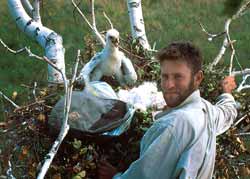DNA from feathers tells tale of eagle fidelity

An Eastern imperial eagle chick scolds Todd Katzner, conservation director with the National Aviary, as he collects feathers from the bird’s nest. Katzner is working with geneticists at Purdue University to use DNA from feathers to help determine the conservation status of this rare central Asian eagle. (Photo courtesy of Todd Katzner)
A trail of feathers led a team of Purdue University scientists to confirm that eagles from central Asia are quite possibly the most faithful of birds.
By performing DNA analysis on the feathers left behind at nesting sites, the researchers were able to identify individual Eastern imperial eagles in a nature reserve in Kazakhstan. Their analysis showed that not one adult strayed from its mate – a degree of fidelity highly unusual among birds, the vast majority of which mate with and raise offspring from multiple partners.
Not only is this study the first to confirm monogamy in eagles, more importantly, it also is the first to rely on feathers collected “noninvasively,” or without trapping and handling, to provide a source of DNA to determine relationships among individuals and determine various population parameters.
“That we were able to use feathers we collected noninvasively as a source of DNA is the number one thing scientists will be interested in,” said Andrew DeWoody, associate professor of genetics and senior author of the study, which was published online Friday (July 1) in the journal Molecular Ecology.
“People have been doing studies like this for several years with mammals, but this is a first for birds.”
By developing a protocol for extracting DNA from feathers, the researchers also have added another tool to help conservation biologists study rare and elusive birds of prey.
The researchers used a technique called DNA fingerprinting to help them genetically “tag” individuals in the population without capture, said Jamie Rudnick, the paper’s first author and a graduate student who conducted the study as part of her doctoral thesis.
“Collecting feathers at the nest site helped us determine population parameters we wouldn’t have been able to otherwise,” she said.
Those parameters, such as yearly survival rates and ratios of males to females, help conservation biologists monitor populations of rare or endangered species. Noninvasive sampling allows biologists to track changes in populations over time without the risks associated with handling live animals, she said.
“Eastern imperial eagles are hard to catch, and individuals are difficult to tell apart,” Rudnick said. “By performing genetic analysis on feathers collected at the site, we were able to track the presence or absence of individual birds over a six-year period.”
This kind of monitoring is essential to conserving rare or endangered species, said Todd Katzner, director of conservation and field research at the National Aviary in Pittsburgh and a study co-author.
“You can’t conserve a population unless you know how big it is and whether it’s growing or shrinking,” Katzner said. “This approach allows us to monitor wild populations in a way that’s less invasive and more cost-effective than other methods.”
Observational studies of imperial eagles suggest these birds, like most large birds of prey, are at least socially monogamous. This means a male-female pair stays together throughout the breeding season and shares responsibility in raising young, DeWoody said.
But just because two individuals act like a pair doesn’t guarantee they’re not having trysts on the sly. In fact, studies over the last decade have shown most broods of socially monogamous birds include offspring from at least two genetic fathers.
“Our study actually stands out as a relatively rare instance in which DNA fingerprinting uncovers genetic monogamy in a bird population,” DeWoody said.
Unlike their smaller songbird cousins, most raptors are believed to be truly monogamous, and this study provides the first genetic confirmation of monogamy in at least one species, DeWoody said.
“It’s very likely that other raptor biologists will follow this with similar studies on other species of interest like bald eagles,” he said.
This project is one part of a larger research program on the eagles of Naurzumski Gosudarstvennyi Zapovednik (Naurzum State Nature Reserve), a large nature reserve in northern Kazakhstan. This reserve supports an unusual diversity of raptors and is home to no less than 24 different species of hawks, eagles, falcons, owls and harriers.
Also participating in this study were Evgeny A. Bragin of the Naurzum State Nature reserve, Karamendy, Kazakhstan; and O. Eugene Rhodes Jr., of the Purdue Department of Forestry and Natural Resources. The Wildlife Conservation Society provided funding for this project.
Media Contact
More Information:
http://www.purdue.eduAll latest news from the category: Life Sciences and Chemistry
Articles and reports from the Life Sciences and chemistry area deal with applied and basic research into modern biology, chemistry and human medicine.
Valuable information can be found on a range of life sciences fields including bacteriology, biochemistry, bionics, bioinformatics, biophysics, biotechnology, genetics, geobotany, human biology, marine biology, microbiology, molecular biology, cellular biology, zoology, bioinorganic chemistry, microchemistry and environmental chemistry.
Newest articles

Security vulnerability in browser interface
… allows computer access via graphics card. Researchers at Graz University of Technology were successful with three different side-channel attacks on graphics cards via the WebGPU browser interface. The attacks…

A closer look at mechanochemistry
Ferdi Schüth and his team at the Max Planck Institut für Kohlenforschung in Mülheim/Germany have been studying the phenomena of mechanochemistry for several years. But what actually happens at the…

Severe Vulnerabilities Discovered in Software to Protect Internet Routing
A research team from the National Research Center for Applied Cybersecurity ATHENE led by Prof. Dr. Haya Schulmann has uncovered 18 vulnerabilities in crucial software components of Resource Public Key…





















